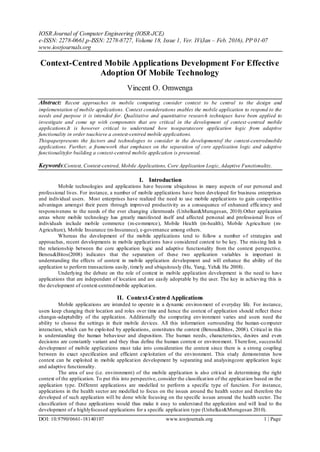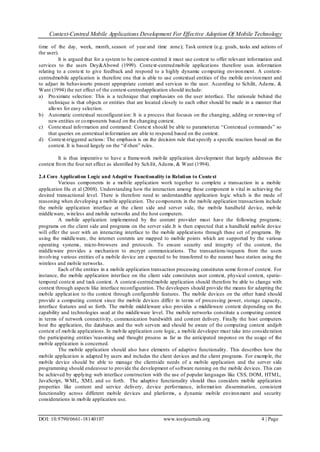This document discusses the development of context-centered mobile applications. It defines context and explains that context-centered applications use contextual information to provide relevant information and services to users. The document then discusses factors that influence mobile application development, such as computing platforms, user context, security, and infrastructure. It also covers core technologies used in development, including communication technologies, development platforms, and positioning techniques. Finally, the document presents a framework for separating core application logic from adaptive functionality to build applications that can adapt to changing context.






![Context-Centred Mobile Applications Development For Effective Adoption Of Mobile Technology
DOI: 10.9790/0661-18140107 www.iosrjournals.org 7 | Page
This framework is divided into two sections; core application logic and the adaptive functionality. Core
application logic has six components that contain critical features a developer should consider and adaptive
functionality comprisesof five components.The framework is then encapsulated by the mobile application
security considerations. Mobile application security affects many of the components in the framework and
therefore must be considered at the component level.
The framework focuses principally on mobile application development where there is a separate host
supporting the mobile application. Each individual or mobile application development company has its different
approach in application development.Mobile application developer needs to have a clear understanding of the
requirements, the rationale of development and the end product in order to gainfully use this framework. Mobile
application developers are free to categorize and emphasize on particular aspects of mobile application
development that will be more useful for each development.
IV. Conclusion
The studyidentified, analysed and separated mobile application development factors and components
into core application logic features and adaptive functionality features.A frameworkthat highlights components
and critical features to be considered in the mobile application is presented. The exploitation of context both on
the core application logic and adaptive functionality will lead to development of acontext-centredmobile
applications. In developing a mobile application, the core application logic and adaptive functionality features
should be considered separately as depicted in the proposed framework. An extension of this study could
consider contextual information and its classifications, that is, user context, computing context, physical context,
spatial-temporal context and task context. Moreover, manner of context acquisition, that is, sensed context,
derived context or where context is explicitly provided could also be considered.
Acknowledgement
I wish to express my gratitude to Strathmore University, Faculty of Information Technology for the Research
funding.
References
[1]. Benou,P., &Bitos, V. (2008), Developing Mobile Commerce Applications. Journal of Electronic commerce in Organizations,
Volume 6, Issue 1.
[2]. Brown, J., Bovey, D., & Chen, X. (1997). Context-Centeredapplications: From the laboratory to the marketplace. IEEE Personal
Communications, 4(5), 58-64.
[3]. Buthpitiya, S., Cheng,H., T., Sun,F., T., Griss,M. &Dey,A.,K.(2011). Hermes: a Context-Centeredapplication development
framework for the Mobile Environment. Carnegie Mellon University.
[4]. Dehlinger, J., &Dixon,J. (2011). Mobile Application Software Engineering: Challenges and Research Directions. Department of
Computer and Information Sciences -Towson University
[5]. Dey, A., &Abowd, G. (1999). Towards a better understanding of context and context-awareness. Technical Report 99-22. Georgia
Institute ofTechnology.
[6]. Gavalas, D., &Economou, D. (2011), Development platforms for Mobile Applications: Status andTrends. IEEE Software.
[7]. Hansmann, U., Merk, L., Nicklous, M., &Stober T. (2003).Pervasive computing. Berlin, Heidelberg, New York: Springer-Verlag.
[8]. Hu,W., C., Yang, C., H.T., Yeh, J., H., & Hu, W. (2008) . Mobile and Electronic Commerce Systems andTechnologies. Journal of
Electronic Commerce in Organizations, Volume 6, Issue 3.
[9]. Oinas-Kukkonen, H., &Kurkela, V. (2003). Developing Successful Mobile Applications. Proceedings of the International
Conference on Computer Science and Technology, (pp. 50-54). Cancun, Mexico.
[10]. Pascoe, J. (1998). Adding generic contextual capabilities to wearable computers. In Proceedings of the 2ndInternational Symposium
onWearable Computers (pp. 92-99).
[11]. Schilit, B., Adams, N., & Want, R. (1994). Context-Centeredcomputing applications. In Proceedings of the 1st
International
Workshop on Mobile Computing Systems and Applications (pp. 85-90).
[12]. Schmidt, A., &Laerhoven, K. (2001). Howto build smart appliances. IEEE Personal Communications, 8(4), 66-71.
[13]. Schilit, B., &Theimer, M. (1994). Disseminating activemap informationto mobile hosts. IEEE Network, 8(5), 22-32.
[14]. Unhelkar, B., &Murugesan, S. (2010). The Enterprise Mobile Applications Development Framework. IT Professional, 12 (3), 33-
39.
[15]. Varshney, U., & Vetter, R. (2001). A Framework for the Emerging Mobile Commerce Applications. Proceedings of the 34th
Annual Hawaii International Conference in System Sciences, 9, pp. 9014-9023.](https://image.slidesharecdn.com/a018140107-160704043054/85/A018140107-7-320.jpg)